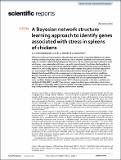Files in this item
A Bayesian network structure learning approach to identify genes associated with stress in spleens of chickens
Item metadata
| dc.contributor.author | Videla Rodriguez, Emiliano Ariel | |
| dc.contributor.author | Mitchell, John B. O. | |
| dc.contributor.author | Smith, V. Anne | |
| dc.date.accessioned | 2022-05-09T14:30:30Z | |
| dc.date.available | 2022-05-09T14:30:30Z | |
| dc.date.issued | 2022-05-06 | |
| dc.identifier | 279304183 | |
| dc.identifier | 483a2d97-44c5-4cad-8951-edf01edde10a | |
| dc.identifier | 85129722747 | |
| dc.identifier | 000791825700030 | |
| dc.identifier.citation | Videla Rodriguez , E A , Mitchell , J B O & Smith , V A 2022 , ' A Bayesian network structure learning approach to identify genes associated with stress in spleens of chickens ' , Scientific Reports , vol. 12 , 7482 . https://doi.org/10.1038/s41598-022-11633-7 | en |
| dc.identifier.issn | 2045-2322 | |
| dc.identifier.other | ORCID: /0000-0002-0379-6097/work/113060866 | |
| dc.identifier.other | ORCID: /0000-0002-0487-2469/work/113060904 | |
| dc.identifier.uri | https://hdl.handle.net/10023/25323 | |
| dc.description | This work was supported by the European Union’s Horizon 2020 research and innovation programme under the Marie Skłodowska-Curie grant agreement No 812777 | en |
| dc.description.abstract | Differences in the expression patterns of genes have been used to measure the effects of non-stress or stress conditions in poultry species. However, the list of genes identified can be extensive and they might be related to several biological systems. Therefore, the aim of this study was to identify a small set of genes closely associated with stress in a poultry animal model, the chicken (Gallus gallus), by reusing and combining data previously published together with bioinformatic analysis and Bayesian networks in a multi-step approach. Two datasets were collected from publicly available repositories and pre-processed. Bioinformatics analyses were performed to identify genes common to both datasets that showed differential expression patterns between non-stress and stress conditions. Bayesian networks were learnt using a Simulated Annealing algorithm implemented in the software Banjo. The structure of the Bayesian network consisted of 16 out of 19 genes together with the stress condition. Network structure showed CARD19 directly connected to the stress condition plus highlighted CYGB, BRAT1, and EPN3 as relevant, suggesting these genes could play a role in stress. The biological functionality of these genes is related to damage, apoptosis, and oxygen provision, and they could potentially be further explored as biomarkers of stress. | |
| dc.format.extent | 8 | |
| dc.format.extent | 1044122 | |
| dc.language.iso | eng | |
| dc.relation.ispartof | Scientific Reports | en |
| dc.subject | Poultry | en |
| dc.subject | Stress | en |
| dc.subject | Bayesian network | en |
| dc.subject | Banjo | en |
| dc.subject | Markov Blanket | en |
| dc.subject | QA75 Electronic computers. Computer science | en |
| dc.subject | QH301 Biology | en |
| dc.subject | SF Animal culture | en |
| dc.subject | 3rd-DAS | en |
| dc.subject.lcc | QA75 | en |
| dc.subject.lcc | QH301 | en |
| dc.subject.lcc | SF | en |
| dc.title | A Bayesian network structure learning approach to identify genes associated with stress in spleens of chickens | en |
| dc.type | Journal article | en |
| dc.contributor.sponsor | European Commission | en |
| dc.contributor.institution | University of St Andrews. School of Biology | en |
| dc.contributor.institution | University of St Andrews. EaSTCHEM | en |
| dc.contributor.institution | University of St Andrews. Biomedical Sciences Research Complex | en |
| dc.contributor.institution | University of St Andrews. School of Chemistry | en |
| dc.contributor.institution | University of St Andrews. St Andrews Bioinformatics Unit | en |
| dc.contributor.institution | University of St Andrews. Office of the Principal | en |
| dc.contributor.institution | University of St Andrews. St Andrews Centre for Exoplanet Science | en |
| dc.contributor.institution | University of St Andrews. Centre for Biological Diversity | en |
| dc.contributor.institution | University of St Andrews. Scottish Oceans Institute | en |
| dc.contributor.institution | University of St Andrews. Institute of Behavioural and Neural Sciences | en |
| dc.identifier.doi | 10.1038/s41598-022-11633-7 | |
| dc.description.status | Peer reviewed | en |
| dc.identifier.grantnumber | 812777 | en |
This item appears in the following Collection(s)
Items in the St Andrews Research Repository are protected by copyright, with all rights reserved, unless otherwise indicated.

